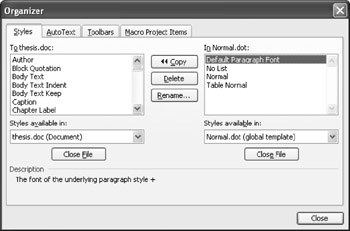Modifying Existing Templates
|
| < Day Day Up > |
|
You can modify existing templates by opening and manually changing the template file; modifying a document that has the template attached and saving changes to the template; or by copying, deleting, and renaming template components using the Organizer. Regardless of how you make changes to a template, when you modify a template, the modifications affect new documents based on the template, but the contents of existing documents are not affected by template modifications unless you specifically instruct Word to apply the new template settings to the document, by configuring options in the Templates And Add-Ins dialog box.
Modifying an Existing Document Template File
To modify an existing document by working directly in the template, you must first open the file as a template from the Open dialog box, as follows:
-
Choose File, Open, select Document Templates in the Files Of Type list, and then locate and open the template you want to modify. By default, templates are stored in the \%UserProfile%\Application Data\Microsoft\Templates folder.
-
Change any of the template's text and graphics, styles, formatting, macros, AutoText entries, AutoCorrect settings, toolbars, menu settings, and keyboard shortcuts, and then click Save on the Standard toolbar.
Remember, whenever you make changes to a document template, you should test the changes by creating a sample new document based on the template. Also, to apply the changes to any existing document to which the template is attached, ensure that the Automatically Update Document Styles check box in the Templates And Add-Ins dialog box is selected after you open the document. (If the option has been previously selected from within a document, the template will update automatically when that document is opened.)
Modifying an Existing Document Template While Working in a Document
You can modify a template while you work in a Word document. For instance, you can add a style to the attached document template by creating a style (as described in Chapter 9, "Using Styles to Increase Your Formatting Power"). In the New Style dialog box (or in the Modify Style dialog box), select the Add To Template check box to add the new style to the currently attached template. When you save the document, Word displays a message box that asks if you want to update the attached document template, as shown in Figure 16-8.

Figure 16-8: You can modify and save changes to an attached document template while you work in a document.
Renaming, Deleting, and Copying Styles Using the Organizer
In addition to modifying templates by making changes in template and document files, you can use the Organizer to manage template components. The Organizer dialog box contains tabs for Styles, AutoText, Toolbars, and Macro Project Items, as shown in Figure 16-9.

Figure 16-9: You can copy, delete, and rename styles, AutoText, toolbars, and macros stored in specific documents and templates by using the Organizer.
To use the Organizer to copy and manage any of these types of elements in documents and templates, follow these steps:
-
Choose Tools, Templates And Add-Ins, and then click Organizer.
-
In the Organizer dialog box, click the tab for the items you want to copy, delete, or rename.
-
To copy items to or from templates or files, click Close File to close the active document and its attached template or to close the Normal template. Then click Open File, and select the template or file you want to open by double-clicking it in the Open dialog box. Select the items you want to copy, delete, or rename, and then click Copy, Delete, or Rename as appropriate.
-
Click Close when you've finished with the Organizer.
Troubleshooting: I can't copy items to a particular template
If you try to copy styles, macros, toolbars, or other items to a template that's protected in some way, you might not be able to open the template, accept or reject tracked changes in the template, or save changes to the template. This problem might be due to any of the following reasons:
-
The template is protected for tracked changes, comments, or forms.
-
The template is encrypted and requires you to enter a password.
-
The template is protected by a password (in other words, a password was added to the Security tab in the Options dialog box). If you don't know the password, you can open the template only as a read-only file.
-
The file attributes are set to read-only.
-
You don't have access to the server on which the template is stored.
-
The template might be open on another computer on your network.
To save changes to a template, the protection settings must be removed from the template, you must gain the proper access permissions, or you must wait until the template is no longer open on another computer on the network.
| Cross-Reference | In some instances, you might want to protect templates. To learn more about protecting documents, see "Protecting Templates," below, as well as Chapter 28, "Addressing Document Protection and Security Issues." |
|
| < Day Day Up > |
|
EAN: 2147483647
Pages: 373